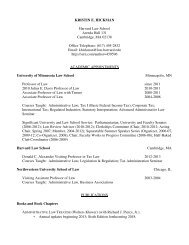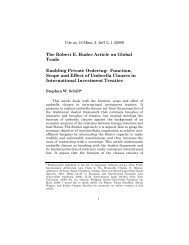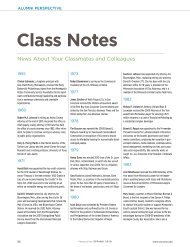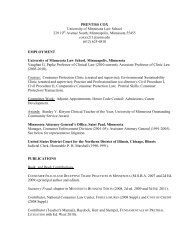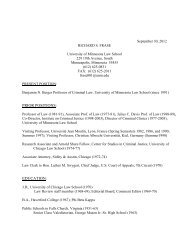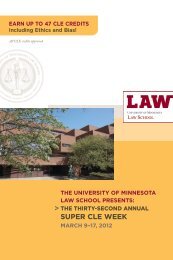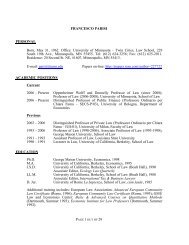The End-of-Life Vehicle (ELV) - the University of Minnesota Law ...
The End-of-Life Vehicle (ELV) - the University of Minnesota Law ...
The End-of-Life Vehicle (ELV) - the University of Minnesota Law ...
Create successful ePaper yourself
Turn your PDF publications into a flip-book with our unique Google optimized e-Paper software.
2009] END-OF-LIFE VEHICLE DIRECTIVE 453<br />
generators,” so that small <strong>ELV</strong> facilities will not be regulated. 164<br />
<strong>The</strong> Comprehensive Environmental Response, Compensation,<br />
and Liability Act (CERCLA) 165 is similarly ineffective. CERCLA<br />
applies only retrospectively; it provides no protection against<br />
pollution o<strong>the</strong>r than <strong>the</strong> specter <strong>of</strong> possible litigation to recover<br />
clean-up costs. 166 In addition to <strong>the</strong>se regulatory problems, <strong>the</strong><br />
United States system <strong>of</strong> automotive recycling is entirely pr<strong>of</strong>it<br />
driven, 167 creating greater susceptibility to economic<br />
fluctuations.<br />
Ano<strong>the</strong>r justification for an EPR-styled system <strong>of</strong><br />
automotive waste recycling is resource conservation. 168 As early<br />
as 1999, <strong>the</strong> feasibility <strong>of</strong> recycled material markets for such<br />
products as plastics, glass, and rubber was being touted. 169 In<br />
fact, <strong>the</strong> market for non-metal recycling in <strong>the</strong> United Kingdom<br />
increased 40% in 2007. 170 Fur<strong>the</strong>rmore, recycling yields energy<br />
savings over virgin material use. 171 However, as long as virgin<br />
materials are available for less, notwithstanding <strong>the</strong><br />
environmental costs <strong>of</strong> <strong>the</strong>ir extraction, refinement, and<br />
subsequent disposal, private actors have little incentive, without<br />
regulation, to develop sustainable raw material acquisition. 172<br />
<strong>The</strong> situation is particularly troublesome given <strong>the</strong> seeming<br />
willingness <strong>of</strong> automotive manufacturers to participate in<br />
elevated recycling efforts. 173 Bill Ford, Chairman <strong>of</strong> Ford Motor<br />
164. Sachs, supra note 16, at 57.<br />
165. 42 U.S.C. §§ 9601–9675 (2005). CERCLA provides for <strong>the</strong> cleanup <strong>of</strong><br />
industrially polluted sites through <strong>the</strong> use <strong>of</strong> <strong>the</strong> “Hazardous Substance Superfund,”<br />
which may be replenished by suits brought under § 107 <strong>of</strong> <strong>the</strong> Act. United States v.<br />
Bestfoods, 524 U.S. 51, 55–56 (1998).<br />
166. See generally 42 U.S.C. §§ 9601–9675. Fur<strong>the</strong>rmore, new legislation has<br />
tended to mitigate CERCLA’s strict assignment <strong>of</strong> liability. NAT’L RISK MGMT.<br />
RESEARCH LAB., supra note 159, at 19.<br />
167. Kumar & Su<strong>the</strong>rland, supra note 71, at 146. This means facilitators <strong>of</strong><br />
<strong>ELV</strong> disposal may forego responsible treatment when it is economically infeasible.<br />
168. One justification for EPR-type waste management is “increase[d] . . .<br />
availability <strong>of</strong> recyclable and recycled materials to encourage substitution for virgin<br />
materials.” T<strong>of</strong>fel et al., supra note 21, at 4.<br />
169. See generally SAE INT’L, VEHICLE RECYCLING, REGULATORY, POLICY, AND<br />
LABELING ISSUES (Soc’y <strong>of</strong> Auto. Eng’rs, Inc. 1999).<br />
170. Research and Markets, supra note 117.<br />
171. For example, energy savings for non-ferrous metals are aluminum, 95%;<br />
copper, 85%; lead, 65%; and zinc, 60%. DEP’T OF THE ENV’T AND HERITAGE, ENV’T<br />
AUSTL., supra note 4, at 7:33. It is estimated that <strong>the</strong> recycling <strong>of</strong> <strong>ELV</strong> metals alone<br />
in <strong>the</strong> United States produces a savings <strong>of</strong> 3 days worth <strong>of</strong> national energy<br />
consumption. Id. at 16.<br />
172. See Short, supra note 27, at 1237.<br />
173. See Staudinger et al., supra note 4, at 39–40 (reviewing <strong>the</strong> recycling efforts<br />
<strong>of</strong> Ford, Daimler-Chrysler, General Motors, and Toyota). Some <strong>of</strong> this amenability




